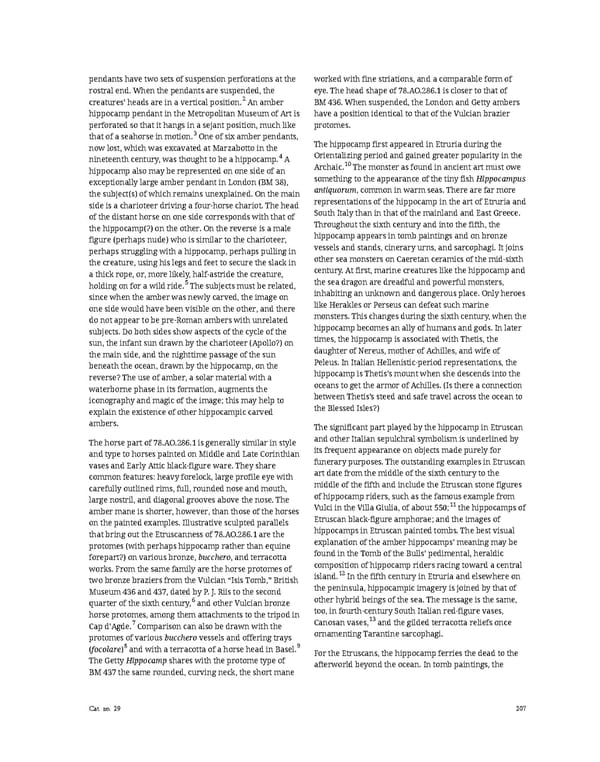pendants have two sets of suspension perforations at the worked with fine striations, and a comparable form of rostral end. When the pendants are suspended, the eye. The head shape of 78.AO.286.1 is closer to that of creatures’ heads are in a vertical position.2 An amber BM436. When suspended, the London and Getty ambers hippocamp pendant in the Metropolitan Museum of Art is have a position identical to that of the Vulcian brazier perforated so that it hangs in a sejant position, much like protomes. that of a seahorse in motion.3 One of six amber pendants, now lost, which was excavated at Marzabotto in the The hippocamp first appeared in Etruria during the nineteenth century, was thought to be a hippocamp.4 A Orientalizing period and gained greater popularity in the Archaic.10 The monster as found in ancient art must owe hippocamp also may be represented on one side of an exceptionally large amber pendant in London (BM 38), something to the appearance of the tiny fish Hippocampus the subject(s) of which remains unexplained. On the main antiquorum, common in warm seas. There are far more side is a charioteer driving a four-horse chariot. The head representations of the hippocamp in the art of Etruria and of the distant horse on one side corresponds with that of South Italy than in that of the mainland and East Greece. the hippocamp(?) on the other. On the reverse is a male Throughout the sixth century and into the fifth, the figure (perhaps nude) who is similar to the charioteer, hippocamp appears in tomb paintings and on bronze perhaps struggling with a hippocamp, perhaps pulling in vessels and stands, cinerary urns, and sarcophagi. It joins the creature, using his legs and feet to secure the slack in other sea monsters on Caeretan ceramics of the mid-sixth a thick rope, or, more likely, half-astride the creature, century. At first, marine creatures like the hippocamp and holding on for a wild ride.5 The subjects must be related, the sea dragon are dreadful and powerful monsters, since when the amber was newly carved, the image on inhabiting an unknown and dangerous place. Only heroes one side would have been visible on the other, and there like Herakles or Perseus can defeat such marine do not appear to be pre-Roman ambers with unrelated monsters. This changes during the sixth century, when the subjects. Do both sides show aspects of the cycle of the hippocamp becomes an ally of humans and gods. In later sun, the infant sun drawn by the charioteer (Apollo?) on times, the hippocamp is associated with Thetis, the the main side, and the nighttime passage of the sun daughter of Nereus, mother of Achilles, and wife of beneath the ocean, drawn by the hippocamp, on the Peleus. In Italian Hellenistic-period representations, the reverse? The use of amber, a solar material with a hippocamp is Thetis’s mount when she descends into the waterborne phase in its formation, augments the oceans to get the armor of Achilles. (Is there a connection iconography and magic of the image; this may help to between Thetis’s steed and safe travel across the ocean to explain the existence of other hippocampic carved the Blessed Isles?) ambers. The significant part played by the hippocamp in Etruscan The horse part of 78.AO.286.1 is generally similar in style and other Italian sepulchral symbolism is underlined by and type to horses painted on Middle and Late Corinthian its frequent appearance on objects made purely for vases and Early Attic black-figure ware. They share funerary purposes. The outstanding examples in Etruscan common features: heavy forelock, large profile eye with art date from the middle of the sixth century to the carefully outlined rims, full, rounded nose and mouth, middle of the fifth and include the Etruscan stone figures large nostril, and diagonal grooves above the nose. The of hippocamp riders, such as the famous example from Vulci in the Villa Giulia, of about 550;11 the hippocamps of amber mane is shorter, however, than those of the horses on the painted examples. Illustrative sculpted parallels Etruscan black-figure amphorae; and the images of that bring out the Etruscanness of 78.AO.286.1 are the hippocamps in Etruscan painted tombs. The best visual protomes (with perhaps hippocamp rather than equine explanation of the amber hippocamps’ meaning may be forepart?) on various bronze, bucchero, and terracotta found in the Tomb of the Bulls’ pedimental, heraldic works. From the same family are the horse protomes of composition of hippocamp riders racing toward a central island.12 In the fifth century in Etruria and elsewhere on two bronze braziers from the Vulcian “Isis Tomb,” British Museum 436 and 437, dated by P. J. Riis to the second the peninsula, hippocampic imagery is joined by that of quarter of the sixth century,6 and other Vulcian bronze other hybrid beings of the sea. The message is the same, horse protomes, among them attachments to the tripod in too, in fourth-century South Italian red-figure vases, 7 Canosan vases,13 and the gilded terracotta reliefs once Cap d’Agde. Comparison can also be drawn with the protomes of various bucchero vessels and offering trays ornamenting Tarantine sarcophagi. (focolare)8 and with a terracotta of a horse head in Basel.9 For the Etruscans, the hippocamp ferries the dead to the The Getty Hippocampshares with the protome type of afterworld beyond the ocean. In tomb paintings, the BM437 the same rounded, curving neck, the short mane Cat. no. 29 207
 Ancient Carved Ambers in the J. Paul Getty Museum Page 216 Page 218
Ancient Carved Ambers in the J. Paul Getty Museum Page 216 Page 218